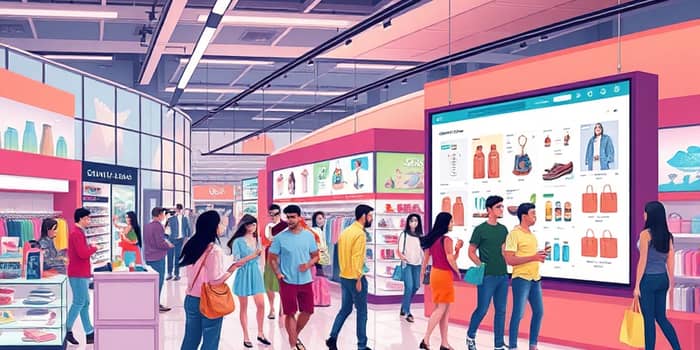
The retail industry stands at a pivotal moment where uncertainty and opportunity intertwine in equal measure. As we analyze the emerging patterns of 2025, it becomes clear that success hinges on understanding the intricate interplay between economic forces, consumer behavior, and technological advancements. From sprawling urban flagship stores to agile direct-to-consumer startups, businesses of all sizes are grappling with questions of how best to connect with their audiences. This comprehensive exploration delves into the latest forecasts, performance metrics, and analytical frameworks that can guide retail leaders toward data-driven strategies. By illuminating key trends and practical techniques, we aim to empower stakeholders with actionable insights that drive sustainable growth and foster adaptability in a rapidly evolving marketplace. Ultimately, the retailers who master the balance between innovation and empathy will define the future of commerce.
Looking ahead to 2025, the National Retail Federation predicts that U.S. retail sales will expand by 2.7% to 3.7%, pushing total revenues to a range between $5.42 trillion and $5.48 trillion. This projection is underpinned by low unemployment and real wage gains, which continue to bolster consumer purchasing power. Despite policy uncertainty and global economic headwinds, retailers can prepare for moderate but steady growth by refining inventory management and aligning supply chains with anticipated demand patterns.
Meanwhile, digital and non-store channels are poised for accelerated expansion, with expectations of 7% to 9% growth, translating to approximately $1.57 trillion to $1.6 trillion in sales. Deloitte’s outlook further underscores these trends, with retail executives forecasting mid-single-digit industry growth and a 4.7% uplift in durable goods spending. In practice, this means that businesses must blend traditional brick-and-mortar strategies with robust e-commerce capabilities to capture a broader slice of the market.
By modeling various scenarios based on these forecasts, retail planners can stress-test budgets, optimize capital allocation, and prioritize investments in technologies that enhance customer engagement and operational efficiency.
The first half of 2025 has delivered a mixed bag of results for U.S. retailers. March witnessed a robust 1.4% increase in sales, largely driven by motor vehicle purchases, only for gains to taper off to a modest 0.1% rise in April. May then saw a 0.9% decline, marking back-to-back monthly contractions. This volatility highlights the sensitivity of consumer spending to factors such as interest rates, inventory availability, and promotional cycles.
Examining sector-specific performance reveals divergent trajectories. The motor vehicle segment surged, while building materials, sporting goods, and food services each carved out moderate gains. Understanding these nuances allows executives to identify the most resilient categories and realign marketing strategies accordingly.
In addition, year-over-year comparisons show non-store retail climbing by 8.3%, while food services and drinking places achieved a 5.3% boost. These figures underscore the growing importance of omnichannel strategies and experiential offerings that blur the line between physical and digital retail environments.
At the heart of retail evolution lies the consumer, whose preferences and sensitivities shape the market’s trajectory. Today’s shoppers display unprecedented diversity across age, household composition, and cultural backgrounds, challenging traditional segmentation models. Retailers must embrace diversification of age, composition, ethnicity to craft personalized experiences that resonate with distinct customer groups.
Even as inflationary pressures moderate, price remains a dominant concern. Shoppers are increasingly vigilant, hunting for value and timing purchases to coincide with promotional events. This dynamic can be characterized by price sensitivity remains a key concern, particularly in essential categories like groceries. To address this, retailers are expanding private-label offerings and deploying targeted discounts through loyalty programs.
Furthermore, experiential retail concepts, such as interactive store displays and live events, are becoming powerful drivers of foot traffic and brand loyalty. These immersive experiences tap into emotional connections, creating memorable moments that data alone cannot replicate.
By synthesizing quantitative insights with qualitative feedback, retailers can design customer journeys that are both efficient and deeply engaging, driving long-term loyalty and repeat purchases.
Analyzing retail data demands a robust methodological toolkit. time-series and regression analysis stand at the forefront, enabling retail analysts to detect seasonal fluctuations, isolate drivers of sales variance, and forecast demand with greater precision. Time-series models, for example, can differentiate between cyclical peaks in holiday shopping and baseline trends, informing inventory decisions and promotional calendars.
Regression analysis, on the other hand, uncovers the relationships between sales outcomes and key variables such as pricing, marketing expenditures, and macroeconomic indicators. By quantifying these effects, retailers gain the confidence to allocate budgets strategically and refine messaging across channels.
Beyond these core approaches, advanced analytics solutions—powered by machine learning—offer dynamic clustering, churn prediction, and anomaly detection. Coupled with CRM platforms that generate customizable dashboards, these technologies democratize insights, allowing frontline teams to act swiftly on emerging trends. Investing in data literacy and governance ensures that analytical outputs remain trustworthy and actionable across the organization.
As the retail landscape grows ever more complex, the ability to pivot rapidly in response to market signals becomes a competitive differentiator. Economic influencers such as labor market shifts and policy changes can reverberate through consumer sentiment, making sustainability and ethical sourcing key differentiators in an era of heightened social awareness. It is no longer enough to offer the right products at the right time; brands must also articulate a clear purpose and commitment to environmental and social responsibility. This underscores that digital transformation of retail ecosystems is not just an option but a strategic imperative. Retailers must cultivate agility by adopting modular supply chains, flexible fulfillment options, and real-time price optimization engines.
To translate insights into results, leadership teams should prioritize the following actions:
By operationalizing these strategies, organizations can navigate uncertainty with confidence and position themselves for sustained profitability.
The revelations unveiled by current retail data underscore a simple truth: knowledge is power. By integrating forecasts, performance analyses, and consumer insights into a cohesive strategic framework, retailers can unlock growth opportunities even amid shifting economic tides. The path forward demands a relentless focus on data-driven decision-making, a willingness to experiment with emerging technologies, and a heartfelt commitment to understanding the evolving needs of every customer.
Armed with these insights, retail leaders are now equipped to chart a course that balances agility with resilience. In doing so, they will not only weather the challenges of 2025 but also set new benchmarks for innovation and customer-centric excellence in the years to come.
References













